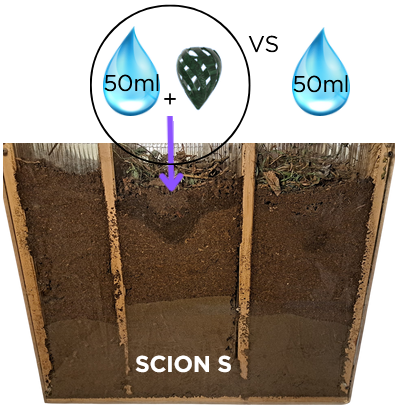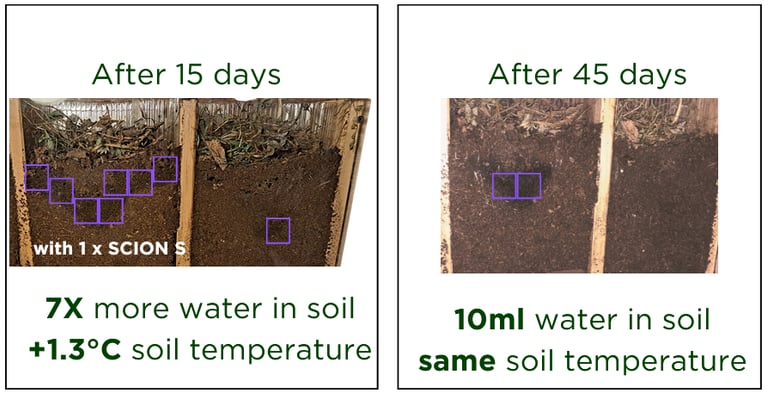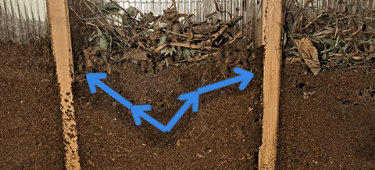White Paper: Water Retention Test of SCION S in Seed Bed Soil
Executive Summary
This white paper presents the findings of a water retention test conducted using SCION S, a proprietary seed pod with water retention and soil activation functions. The study aimed to evaluate the effectiveness of SCION S in improving soil moisture retention and its impact on soil temperature. The results demonstrate significant improvements in water retention and soil activation, with potential applications in agriculture and land management.
Methodology
The experiment was conducted using two separate plexiglass containers filled with seed bed soil. One container included a SCION S inserted 4 cm from the top of the soil in the center, while the other served as a control. Both containers received 50 ml of clean water at the start of the experiment. The test was conducted at a temperature range of 12-15°C.


Key Findings
Water Retention
After 15 days, the container with SCION S retained approximately 7 times more water than the control container.
Visual observation through the plexiglass containers showed that the soil with SCION S had 7 times more humid area, indicating an estimated 35 ml of retained water.
At 45 days, the SCION S container still retained 10 ml of water, while the control container had dried out.
By 90 days, all water had evaporated from both containers.


Soil Activation
The temperature in the SCION S container was 1.3°C higher than the control, indicating active soil activation function.
Long-term Performance
When the test was repeated after 90 days, the water retention capability of SCION S was reduced to 1/5 of its initial performance, suggesting partial decomposition of the water retention formula.
Water Distribution
The V-shape of SCION S created a "hopper" effect, concentrating water retention approximately 2 cm above the top of the V-shape and 2 cm below the soil surface.


Water Retention Mechanism
SCION S demonstrated remarkable water retention capabilities, likely due to its proprietary composition. The ability to retain 7 times more water than the control suggests that SCION S could significantly improve soil moisture management in agricultural applications
Soil Activation
The observed temperature increase in the SCION S container indicates enhanced microbial activity, which could potentially improve nutrient availability and overall soil health
Biodegradability
The reduction in water retention capability after 90 days suggests that SCION S is biodegradable. This property is advantageous for environmental sustainability but may require periodic reapplication in long-term use scenarios
Water Distribution Pattern
The observed "hopper" effect of water concentration above the V-shape of SCION S could be beneficial for directing water to the root zone of plants. This targeted moisture distribution may enhance water use efficiency in crop production
Estimated Effective Radius
Based on the shape and water retention capability of SCION S, it is estimated that its effective radius for connecting water molecules is approximately 20-30 cm from the center of the device. This estimation suggests that SCION S could influence soil moisture over a significant area, potentially benefiting multiple plants in its vicinity
Conclusions
SCION S demonstrates significant potential for improving water retention and soil activation in seed bed soils. Its ability to retain moisture for extended periods, coupled with its biodegradability, makes it a promising solution for sustainable agriculture and land management practices.
Next steps
Investigate the optimal spacing and depth for SCION S placement to maximize its effectiveness in different cropping systems.
Explore the potential synergies between SCION S and other soil amendments or irrigation techniques to further enhance water use efficiency.
Develop strategies for the periodic reapplication of SCION S to maintain its effectiveness over long-term use.
Conduct further studies to precisely determine the effective radius of SCION S and its impact on root development and plant growth.
By leveraging the unique properties of SCION S, agricultural practitioners and land managers can potentially improve water conservation, soil health, and crop productivity in water-limited environments.
